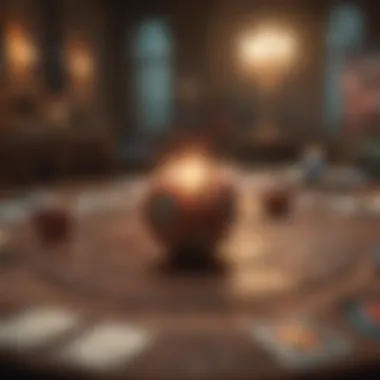Mastering the Art of Deck Building in Magic: The Gathering - A Comprehensive Guide


Game Reviews
Magic: The Gathering stands as a pinnacle of strategic and intellectual gaming, captivating players with its intricate gameplay dynamics and compelling card strategies. The game offers a vast collection of cards, each with unique abilities and synergies. Players must strategically build decks to outmaneuver their opponents in epic duels where every move counts towards victory.
It's essential to understand the fundamental aspects of the game. Magic: The Gathering involves casting spells, summoning creatures, and activating powerful enchantments to outsmart your opponent. Each player starts with a deck of cards representing various spells, creatures, and artifacts, aiming to reduce their opponent's life total to zero.
The game's mechanics are deeply strategic, where players must anticipate their opponent's moves, adapt to changing game states, and make calculated decisions to achieve dominance. The interplay of cards, mana resources, and player interactions creates a complex and rewarding gaming experience for enthusiasts.
In terms of graphics and sound quality, Magic: The Gathering offers visually stunning card art that immerses players in a fantastical world of spells and creatures. The sound effects and music enhance the gameplay experience, adding depth and atmosphere to the intense battles unfolding on the tabletop.
Analyzing the pros and cons, the game's rich strategic depth and customizable deck-building options provide endless possibilities for creative gameplay. However, the learning curve can be steep for newcomers, requiring dedication and practice to master the nuances of card interactions and game strategies.
Understanding the Basics of Deck Building
In the realm of Magic: The Gathering, a strategic collectible card game renowned for its complexity, mastering the art of deck building is a fundamental skill that can make all the difference between victory and defeat. Understanding the basics of deck building serves as the cornerstone of a player's journey towards creating a formidable deck that aligns with their playstyle and strategic objectives. By delving into the core principles and strategies behind deck construction, players can cultivate a deep appreciation for the intricacies of the game and develop a competitive edge that sets them apart from their adversaries. This section of the article will delve into the importance and nuances of grasping the basics of deck building, providing invaluable insights that will empower players to craft decks with precision and purpose.
Choosing Your Deck Archetype
When embarking on the process of deck building in Magic: The Gathering, one of the critical decisions that players must make is selecting their deck archetype. The deck archetype serves as the strategic foundation upon which the entire deck is constructed, dictating the overall playstyle, strengths, and weaknesses of the deck. Whether players opt for an aggressive aggro deck, a versatile midrange deck, a control-focused control deck, or a combo-centric combo deck, the choice of archetype profoundly influences the gameplay experience and strategic options available to the player. By carefully considering factors such as personal preferences, metagame trends, and strategic objectives, players can choose a deck archetype that resonates with their playstyle and enhances their chances of success on the battlefield.
Identifying Key Components
In the intricate tapestry of deck building, identifying key components is akin to unraveling the threads that weave together to create a cohesive and formidable deck. Key components encompass a wide array of elements, including but not limited to mana sources, win conditions, removal spells, card draw engines, and synergy-driven cards. By meticulously analyzing and selecting these components, players can ensure that their deck functions harmoniously, synergizing to execute their game plan with precision and efficiency. Moreover, identifying key components allows players to strengthen the strategic cohesiveness of their deck, mitigating weaknesses and maximizing strengths to achieve optimal performance in diverse gaming scenarios.


Establishing a Mana Curve
At the heart of every successful deck lies a well-established mana curve, a pivotal aspect of deck construction that influences gameplay dynamics and consistency. The mana curve represents the distribution of mana costs across the cards in a deck, ensuring that players have access to the appropriate mana resources needed to cast their spells and creatures at different points in the game. By strategically shaping the mana curve to accommodate a balanced mix of low-cost, mid-cost, and high-cost cards, players can navigate varying stages of the game effectively, adapting to different board states and opponent strategies. Establishing a mana curve that aligns with the deck's overarching strategy is essential for maintaining tempo, resilience, and adaptability throughout the course of a match, ultimately culminating in victory and glory on the battlefield.
Strategic Card Selection
Strategic card selection is a critical aspect of deck building in Magic: The Gathering. Choosing the right cards can make the difference between victory and defeat in this complex card game. It involves analyzing each card's role within your deck and how they interact with each other. By strategically selecting cards that complement your deck's strategy, you can maximize your chances of success on the battlefield. Understanding the synergies and interactions between different cards is key to creating a cohesive and effective deck.
Understanding Card Synergies
Understanding card synergies is essential in strategic card selection. Synergy refers to the interaction between cards that amplify their individual strengths when played together. Identifying and utilizing synergies can lead to powerful combinations that can turn the tide of a game in your favor. Effective synergies can create versatile strategies and unexpected moves that catch your opponent off guard, giving you a significant advantage on the battlefield.
Assessing Card Value
Assessing the value of cards is crucial when selecting which ones to include in your deck. Card value is determined by a combination of factors, including its mana cost, abilities, and impact on the game. It's important to evaluate cards based on how well they fit into your deck's overall strategy and their potential impact on different game scenarios. By assigning a value to each card based on its utility and effectiveness in your deck, you can make informed decisions that enhance your deck's performance.
Achieving Balance in Card Types
Achieving balance in card types is necessary for a well-rounded deck. A balanced mix of creatures, spells, and other card types ensures that your deck can handle various situations effectively. Including too many of one type of card can make your deck vulnerable to specific strategies or counterplay. By diversifying your card types and including versatile options, you can adapt to different playstyles and strategies, increasing your deck's overall resilience and versatility on the battlefield.
Incorporating Removal and Counterplay
Incorporating removal spells and cards that counter your opponent's strategies is vital for maintaining control of the game. Removal spells allow you to deal with threats on the battlefield, while counterplay cards disrupt your opponent's plans and prevent them from executing their strategy. By including a balance of removal and counterplay cards in your deck, you can react to your opponent's moves effectively and maintain a strategic advantage throughout the game.
Crafting Your Winning Strategy


In the realm of Magic: The Gathering, crafting a winning strategy is not just a choice but a necessity for achieving success in gameplay. Understanding the significance of this topic is crucial as it forms the foundation upon which your deck's performance hinges. When delving into the art of deck building, developing a coherent and effective strategy is akin to setting the stage for victory. Crafting Your Winning Strategy involves meticulous planning, foresight, and adaptability to outmaneuver opponents and secure triumph on the battlefield. By focusing on specific elements such as synergy between cards, adaptability to different playstyles, and strategic resource management, players can enhance their chances of achieving victory in the game.
Defining Your Game Plan
Defining Your Game Plan serves as the cornerstone of a successful deck-building endeavor in Magic: The Gathering. It involves outlining your primary objectives, identifying key win conditions, and strategizing how to achieve them during gameplay. This step is paramount as it sets the tone for the entire deck construction process. By defining a clear and concise game plan, players can streamline their card selections, optimize their deck's performance, and increase their chances of executing decisive moves during matches. Additionally, a well-defined game plan provides a roadmap for navigating complex game scenarios, maximizing strategic decisions, and ultimately dominating opponents with precision and foresight.
Adapting to Different Playstyles
Adapting to Different Playstyles is a crucial skill that distinguishes adept Magic: The Gathering players from novices. As the game encompasses a diverse range of strategies, playstyles, and tactics, being able to adapt effectively to varying approaches is essential for success. Understanding the nuances of different playstyles allows players to anticipate opponents' moves, counteract their strategies, and capitalize on their weaknesses. By developing the flexibility to adjust your gameplay tactics on the fly, you can stay one step ahead of your rivals and seize pivotal opportunities to turn the tide of the game in your favor.
Testing and Iterating Your Deck
Testing and Iterating Your Deck is a critical phase in the deck-building process that cannot be overlooked. This stage involves playtesting your deck in various scenarios, analyzing its performance, and refining its composition based on empirical results. By subjecting your deck to rigorous testing, you can uncover its strengths and weaknesses, identify areas for improvement, and fine-tune its mechanics for optimal efficiency. Iterating on your deck through successive rounds of testing allows you to hone its competitive edge, adapt to evolving metagame trends, and sharpen your strategic acumen through hands-on experience. Ultimately, testing and iterating your deck not only enhances its overall performance but also empowers you to stay ahead of the ever-shifting dynamics of Magic: The Gathering gameplay.
Fine-Tuning Your Deck
In the realm of Magic: The Gathering, fine-tuning your deck emerges as a crucial phase in the deck-building process. This segment is where intricate adjustments are made to elevate your deck's performance to its peak potential. By focusing on specific elements such as card synergies, mana curve optimization, and strategic card selection, players can refine their decks to establish a cohesive and effective gameplay strategy. The significance of fine-tuning your deck lies in the ability to adapt to diverse playstyles, anticipate opposing strategies, and maximize the synergies between cards. Through meticulous adjustments and strategic choices, players can fine-tune their decks to achieve a balance between consistency and flexibility, ultimately enhancing their chances of victory.
Optimizing Land Base
Optimizing the land base of your deck is a fundamental aspect of deck building that has a significant impact on gameplay. The land base comprises of lands that provide mana, the essential resource to cast spells and deploy creatures in the game. By strategically selecting and fine-tuning the land distribution in your deck, you can ensure a smooth mana curve and consistent access to the mana colors required for your cards. Balancing the number of basic lands, dual lands, and utility lands is vital to support your deck's strategy and enable seamless gameplay. Optimizing the land base involves assessing the mana requirements of your cards, considering the curve of your deck, and adjusting the land ratio to minimize the risk of mana screw or mana flood, thus improving the overall performance and consistency of your deck.
Adjusting Card Ratios


The adjustment of card ratios plays a pivotal role in fine-tuning your deck to achieve optimal functionality and synergy. Card ratios refer to the proportion of different card types present in your deck, including creatures, spells, and other support cards. By carefully adjusting these ratios based on your deck archetype and strategy, you can enhance the deck's overall cohesiveness and effectiveness. Balancing the number of threat cards, answers, and card draw options is essential to ensure consistent draws and responses during gameplay. Adjusting card ratios also involves evaluating the mana cost distribution of cards, considering the curve of the deck, and making strategic decisions to improve the flow and efficiency of your deck. By optimizing card ratios, players can create a well-rounded and versatile deck capable of handling various situations and opponents with proficiency.
Sideboarding for Flexibility
Sideboarding for flexibility is a strategic technique used by players to adapt their decks to specific matchups and counter different strategies effectively. The sideboard provides players with the opportunity to customize their decks between games in a match, allowing them to incorporate specialized cards that can bolster their game plan or address specific threats posed by an opponent. By including versatile sideboard options such as removal spells, artifactenchantment destruction, or niche cards that target specific strategies, players can enhance their deck's adaptability and resilience in diverse gaming scenarios. Sideboarding for flexibility involves anticipating common matchups in the metagame, identifying potential threats, and selecting sideboard cards that can swing the game in your favor. By mastering the art of sideboarding, players can fine-tune their decks to navigate challenging matchups with strategic sophistication, thereby increasing their chances of success in competitive play.
Mastering the Art of Deckbuilding
Mastering the art of deckbuilding is a pivotal aspect in the realm of Magic: The Gathering. This section delves deep into the core essence of constructing decks that not only resonate with players but also excel in gameplay dynamics. Understanding the nuances of deckbuilding lays the foundation for strategic foresight and adaptability during matches. By mastering this art, players can elevate their gaming experience to unparalleled heights. Embracing creativity and innovation, studying metagame trends, and engaging with the community are key components that contribute to honing this crucial skill.
Embracing Creativity and Innovation
Embracing creativity and innovation in deckbuilding is akin to breathing life into a deck. This creative process involves exploring unconventional card interactions, synergies, and strategies that can catch opponents off guard. Innovative deck designs challenge the status quo and pave the way for groundbreaking gameplay experiences. By encouraging out-of-the-box thinking and experimenting with unique card combinations, players can unlock new dimensions of strategy and surprise their adversaries.
Studying and Analyzing Metagame Trends
Studying and analyzing metagame trends is akin to reading the pulse of the gaming community. By understanding the current trends, popular strategies, and prevailing card choices, players can adapt their decks to stay one step ahead of the competition. Analyzing metagame data provides invaluable insights into emerging tactics and counters, enabling players to make informed decisions when refining their decks. Keeping a keen eye on metagame shifts empowers players to anticipate opponent choices and tailor their decks for maximum impact.
Seeking Feedback and Engaging with the Community
Seeking feedback and engaging with the community fosters a collaborative environment where players can share ideas, receive constructive criticism, and refine their deckbuilding skills. Community feedback offers diverse perspectives and recommendations that can enhance deck performance and strategic depth. Through active participation in forums, local game stores, and online communities, players can gain valuable insights, test their decks against varied playstyles, and forge connections with fellow enthusiasts. The symbiotic relationship between seeking feedback and community engagement ultimately cultivates a vibrant gaming community dedicated to continuous improvement and mutual growth.
Conclusion
In the realm of deck building within the intricate world of Magic: The Gathering, the conclusion serves as the fulcrum upon which the entire deck-building process pivots. It is not merely a summary but a critical evaluation of the choices made and the strategies honed throughout the deck construction journey. Understanding the importance of the conclusion is paramount, as it encapsulates the essence of the deck, reflecting the player's style, preferences, and strategic acumen.
When delving into the realm of conclusion, players must reflect on every facet of their deck - from the initial archetype chosen to the fine-tuning adjustments made along the way. This retrospective process allows players to gain insights into their decision-making, strengths, and potential areas for improvement. Embracing the conclusion as a pivotal moment in deck building empowers players to refine their skills, evolve their strategies, and adapt to the ever-changing metagame landscape.
The benefits of a well-crafted conclusion are multifaceted. It not only provides closure to the deck-building process but also offers a platform for continuous growth and refinement. By analyzing the successes and failures encountered during gameplay, players can derive valuable lessons that inform future deck-building endeavors. Additionally, the conclusion acts as a cornerstone for strategic development, enabling players to refine their playstyle, adapt to varied opponents, and anticipate potential challenges with foresight and precision.
Considerations about the conclusion in this comprehensive guide extend beyond mere summarization. It underscores the dynamic nature of deck building, highlighting the iterative process of construction and refinement. As players navigate through the complexities of card selection, synergy assessment, and strategic adaptation, the conclusion emerges as a beacon of insightful reflection and strategic foresight. By acknowledging the importance of the conclusion and integrating it seamlessly into the deck-building process, players can elevate their gameplay, cultivate their strategic mindset, and embark on a continuous journey of growth and mastery in Magic: The Gathering.



